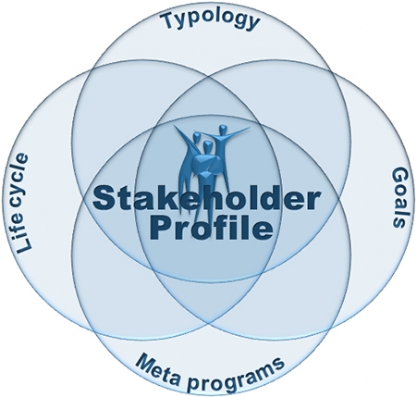Stakeholder profile
Stakeholder profile is a model for the characterization of target groups, in order to align communication and other measures to it. This happens through an open classification of the target groups with the four areas of the model. In teams the joint development of the stakeholder profile is basis for effective, focused group work, since all participants will presuppose the same or at least a similar understanding concerning the target group. The characterization uses pictures, role models, form-free descriptions or structured profiles. This model offers an essential structure for a holistic profile.
During profiling of the target group, it should be always considered that the stakeholder profile provides just an impression of the target group. Like a map is not the territory, the stakeholder profile is not the target group or a target group member. For this reason target groups should be continuously observed, in order to improve the profile again and again due to new impressions.
Stakeholder profile is divided into four areas: typology, life cycle, goals and metaprograms.

Typology
offers a picture of the target group due to general characteristics, like fundamental business type (e.g. developer, producer, vendor, and administrator), change perspective (e.g. vision, action, logic) and fundamental life mode (e.g. doing, being, and having).
Life cycle
describes the current status of the target group by using a life cycle model. Thus it is determined whether the target group is in growth, a productive or final phase.
Goals
describes the core goals of the target group. It describes, whether the target group is concerned about influence, respect, interaction, interest, and well-being.
Metaprograms
are characteristics of the target group, which define their perception, communication and behavior. This includes world view (e.g. chunk size), organization (e.g. focus), process (e.g. planning style), attitude (e.g. representation style) and relationship (e.g. communication style).
From the stakeholder profile intuitively arise strategies for action. Example is a target group with the characteristics of a vendor, with visions, goal mode being, that is growing, wants to influence, focuses on the whole, is interested in humans, decides spontaneously, is mainly visually oriented, and shares information openly. This target group should be approached with a sales oriented language, future orientation, various visualization, few details, status perspectives, a general direction, short term planning opportunities and generous information exchange.
